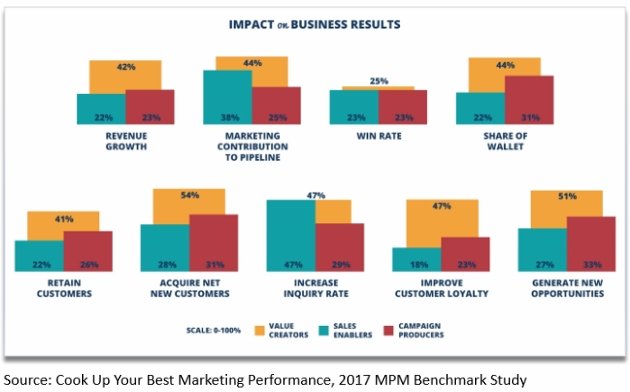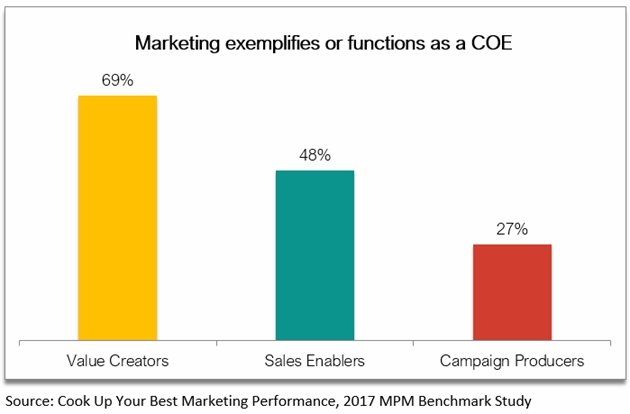Marketing accountability—the ability to measure the marketing organization's contribution to enterprise value—remains a critical issue.
A recent study by Forbes CMO and Neustar, "Accelerating Growth Through Marketing Performance Management" (MPM), found that the senior leadership within Global 5000 organizations recognizes that Marketing accountability is essential to creating shareholder value and organic growth. It echoes our own MPM research, which finds that most chief marketing officers struggle to communicate the value of Marketing to their leadership.
Marketing accountability requires superior alignment with the business, the right data and analytics, and process and measurement skills. Yet our research and the Forbes study found that data, modeling, dashboards, and measurement are the top skills gaps among Marketing organizations with regard to MPM.
So, it is no surprise that 75% of the Global 5000 CMOs surveyed by Forbes indicated that their inability to communicate, quantify, and optimize the value of Marketing hurts them both professionally and personally.
Some marketing organizations are excelling at MPM and, as a result, achieving better growth outcomes for their companies. Compared with "Campaign Producers" and "Laggards," these high-performing organizations excel at achieving business outcomes and exceeding the organization's growth plans, by as much as 20%, and even more for some business results. We refer to this elite group of marketing organizations as "Value Creators."

Value Creators aggressively improve their MPM efforts. How? They operate Marketing as a center of excellence (CoE). In fact, Value Creators are almost three times more likely to exemplify or function as a CoE.

What Is the Purpose of a Center of Excellence?
So what is a CoE? It's an organizational structure that serves as a centralized hub for driving governance, visibility, and accountability for a specific area. A CoE provides leadership, fosters best-practices, facilitates research, and enhances the skills needed to drive business results.
A CoE provides the entire organization with visibility into quality and performance parameters. In this instance, we're talking about Marketing, but the concept of a CoE is applicable to all areas of the business—whether it's Manufacturing, HR, or Customer Support. The purpose of a CoE is to develop standardized, evidence-based processes that ensure high-quality outcomes, which include better customer experiences.
A Marketing CoE helps the organization employ best-practices to improve internal business processes, customer-centricity, market leadership, and market innovation.
A marketing organization that is serious about driving a consistent approach needs to establish and document a set of practices and standards. This is essentially the work of a CoE:
- Define a common set of best-practices and work standards.
- Guide and assist—either directly or through instructional content, tools, templates, etc.—in the implementation of those best-practices and work standards.
- Develop a governance process for those practices and standards.
How Do I Start Creating a Marketing Center of Excellence?
Because of the potential impact of MPM on the business, it makes sense to have MPM as the first focus of your Marketing CoE. In our experience establishing centers of excellence for marketing organizations, we've learned over the past five years that there are four essential success factors:
1. Appoint an executive sponsor
An executive sponsor enables the Marketing CoE to succeed and thrive. Management commitment to schedule the time for COE activities is critical. An executive sponsor with "skin in the game" ensures that the new processes and best-practices permeate the organization and realize their full potential.
2. Define goals and success criteria
A Marketing CoE needs to be absolutely clear about its purpose, what constitutes success, and what measures will be employed. Establishing those early on is pivotal to success and will be the only way to monitor progress.
Document the CoE's charter and purpose, and the value and outcomes the CoE will deliver. Once you have defined the goals and expectations, map the processes to achieve those goals.
3. Establish the initial plan of action
At the outset, the CoE should focus on...
- Reviewing all existing tools, policies, and procedures to determine which are applicable to MPM, and to identify gaps that need to be filled
- Defining MPM methodologies and best-practices
- Providing reusable tools and templates
- Ensuring connectivity between Marketing's activities and investments with business outcomes
- Selecting and providing expertise in the use of the tools
- Providing guidance and performing reviews for all of Marketing's planning, metrics, and dashboard projects
4. Equip staff with skills and tools
It takes more than lip service to create a CoE. You need people who have the passion, vision, and the skills (analytical, planning, project management, process/operational, and soft skills related to change management, such as communication, collaboration, etc.) to facilitate Marketing's path to excellence. There will no doubt be setbacks, so team members need to be resourceful and committed.
Establish an organizational structure and process framework. It is important to determine who is going to lead the Marketing CoE, how your CoE is going to run, and what the individual roles will be for members of the team. Define and document the processes associated with the operation of the CoE.
Bonus: Establish change-management processes
An area of improvement or a business opportunity is the catalyst for a CoE. Hence, by its nature, it is an entity of change. The CoE will need to take change management into account as part of having its work adopted by the broader organization.
The CoE becomes a repository of methodologies and best-practices, and this repository will grow over time.
Initially, members of the CoE team will be actively involved across the marketing organization. As the rest of the marketing team gains the skills and capabilities, active day-to-day CoE member involvement should diminish, with team members eventually serving as mentors.
As part of the change management process, a CoE member should participate in every project kickoff to ensure alignment, accountability, and data requirements. The CoE should lead the "lessons learned" debrief sessions.
Why Invest in Launching a Marketing Center of Excellence?
Launching a Marketing CoE, or any CoE for that matter, takes energy, resources, and time. Why do it? Because it can provide a platform for alignment, quality improvement, and reduced costs while improving market differentiation and increasing revenue and customer satisfaction.
Centers of excellence have been proving their value for more than five years. No longer just a nice-to-have, they are a must-have to for businesses that want to remain competitive.
For an enterprise undertaking its first CoE initiatives, it is essential to set the goals for the COE realistically. Don't expect your CoE to be up and running right away. You should anticipate that as the marketing organization transforms and the CoE matures, the initial recommendations and best-practices will evolve. Keep in the mind the reasons to encourage Marketing to operate as a CoE is to improve business results.
When starting your CoE, it is wise to tap an external consultant who specializes in the CoE focus area—in this case, a firm with deep expertise in MPM—to streamline and accelerate the effort, help avoid pitfalls, and provide insights based on successful experience with similar organizations.
Bringing an objective view, that firm will not get bogged down by what might be real but breakable barriers. Your external consultant should also be able to serve as a coach to the team, transferring knowledge so they can successfully maintain and improve the CoE over time.
Have more questions? Reach out to request our 12-page "What You Must Know About Marketing Centers of Excellence: A Why and How Primer" whitepaper.




